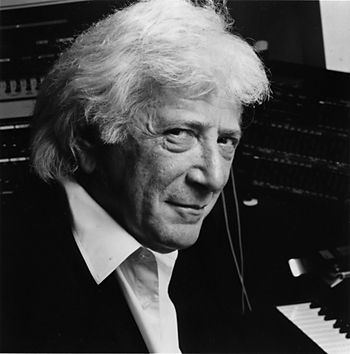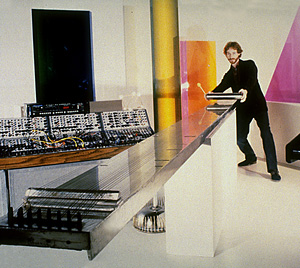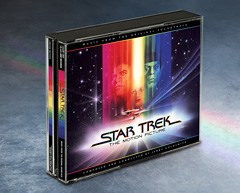

  |
|
|
||||||||||||||||||||||
|
FMS FEATURE... May 29, 2012 Goldsmith Star Trek Score Celebrated Hollywood screening, panel slated by Jon Burlingame  Jeff Bond, author of The Music of Star Trek, will moderate a panel of film professionals associated with the film and its music: original album producer (and longtime Goldsmith scoring mixer) Bruce Botnick; musician Craig Huxley, who will perform on the Blaster Beam percussion instrument that was the voice of the film's V'ger; composer David Newman, who played violin on the original sessions; cinematographer Richard H. Kline; film restoration supervisor and album co-producer Mike Matessino; sound effects editor Mark Mangini; re-recording mixer Steve Maslow; and Goldsmith's longtime agent Richard Kraft. The album will be available that night, a few hours before its availability to the general public. Botnick and Huxley will be signing albums. La-La Land is pressing 10,000 copies as a limited edition, on sale June 5. Goldsmith received the 12th of his 18 Academy Award nominations for the score. That original big-screen reunion of the TV series cast was the first of his five Star Trek film scores: he scored Star Trek V: The Final Frontier (1989) with the original cast, as well as the Next Generation films First Contact (1996), Insurrection (1998) and Nemesis (2002). He also won an Emmy for his theme for Star Trek: Voyager (and later conceded he was sorry that he didn't make time to compose the theme for Deep Space Nine, which he had been asked to do). Goldsmith's score is widely considered one of the musical masterpieces of filmed science fiction. The composer was no stranger to sci-fi, having written music for TV's Twilight Zone (1960-61), received an Oscar nomination for his brilliantly avant-garde Planet of the Apes (1968) and gone on to box-office success with the fascinating blend of orchestra and electronics in Logan's Run (1976) and the complex, suspenseful music of Alien (1979). For the restoration, La-La Land was able to draw from both the Paramount Pictures vaults and those of Columbia Records, which paid an estimated $500,000 – essentially covering the costs of the recording sessions – in return for soundtrack album rights. (Columbia issued the original 40-minute LP, which reached no. 50 on the Billboard album charts in early 1980; and an expanded, 65-minute CD of the score in 1998.) "Goldsmith got an Oscar nomination, and many people felt he should have won the award for the score, which was certainly the most iconic music score written in 1979," says Trek music expert Bond. "It was also a transitional score for Goldsmith, where he started moving in a more romantic direction after years of very experimental, often dissonant music." Adds composer David Newman, who played violin on the 1979 sessions: "It's more tonal, more populist," than other Goldsmith scores of the time. "The harmonies that he used, the orchestration and the structure, satisfied his modernist bent." Reflected Goldsmith, in a 2000 interview with film restoration supervisor Matessino: "I always liked doing those kinds of pictures because there was such great imagination going into the creation of the stories, and it gave me as a composer a very broad palette.... The basic premise of Star Trek is about a better world where we can live in peace and tranquility with one another. It's a lovely thought and part of its universal appeal." Goldsmith was on board more than a year before he would begin work on the film, having been announced as composer when the film itself was announced by Paramount on March 28, 1978. (Goldsmith and director Robert Wise had previously collaborated on The Sand Pebbles in 1966.) But the 1979 schedule would prove complicated and difficult for the composer, as the film's notoriously troubled production – primarily the late delivery of visual effects – resulted in rewrites and late-night recording sessions right up until less than a week before the film's premiere on Dec. 6, 1979 in Washington, D.C. Goldsmith's first three sessions – on Sept. 24, 25 and 27, 1979, each with a 92-piece orchestra on the 20th Century-Fox scoring stage – produced about 30 minutes of recorded music, most of which was discarded. What little film Goldsmith had to score was riddled with numerous "scene missing" cards. Wise was unhappy, Goldsmith recalled. He had been scoring scenes depicting the Enterprise in drydock, and departing for deep space, with an approach that Wise likened to "music for sailing ships." "Goldsmith started off with more of a nautical approach to the Enterprise," Bond says. "The first version of the launch cue actually has an underwater feel to it, and the initial look at the Enterprise is far more grand and sweeping, without that pumping, rhythmic element that drove the version in the film. The three big visual effects sequences – the Enterprise in drydock, the launch, and Spock's arrival on a shuttlecraft – sound so different they really qualify almost as concert pieces that exist apart from the final score." Hearing Wise's disapproval, Goldsmith admitted: "I was crushed." Wise pressed for a strong, recognizable theme – the seeds of which are present in the unused "Enterprise" music on Disc 2 of the new set – and Goldsmith labored to come up with the now-familiar Star Trek theme that adorns the film and later became (at creator Gene Roddenberry's insistence) the signature for TV's Star Trek: The Next Generation. "I had to be kickstarted into the right direction, and it was an expensive lesson," the composer said. The new theme was recorded when sessions resumed on Oct. 23 and 25, 1979. But more problems arose. Botnick, who was brought on board by Columbia Records as executive producer of the soundtrack album, wanted to record the score digitally, and brought in a Sony PCM-1600 recorder. "Jerry was always very much interested in the latest technology," Botnick recalls. "We ran it side-by-side against the analog multi-track." But some musicians were confused, and frightened, by the concept of digital recording. "Because we had two recorders, somehow the union got involved and insisted we make two payments; it was idiotic," recalled Goldsmith. Added Botnick: "They threatened to shut us down. So we recorded the rest to analog 2-track and transferred to the digital; everything [for the soundtrack] was edited and mastered off the digital." The Botnick-Goldsmith collaboration began on Star Trek and continued for the rest of the composer's career, with Botnick his preferred scoring mixer for nearly 50 more films.  Craig Huxley and his Blaster Beam Goldsmith had accepted the assignment on the condition that he not be "saddled," as he put it, with Alexander Courage's original television theme. Eventually, however, all decided that there needed to be some reference, so Goldsmith brought in Courage to adapt it for two "Captain's Log" scenes in the film. Another veteran of the original series, Fred Steiner, pitched in to help out Goldsmith as time was running out; Steiner contributed to several cues but always insisted that he wrote nothing original and merely adapted Goldsmith's material as necessary. The bulk of the score was written and recorded in November 1979; the film had to be finished because 800 theaters had booked it to open on Friday, Dec. 7. Orchestras of 93 to 96 players recorded on Nov. 1, 2, 14, 15, 21, 25, 26, 27 and 29. "We had recordings scheduled every night, and sometimes I'd go to the studio and the orchestra would be sitting there with no music because I had no film to write to," Goldsmith recalled. "So we'd record something over again. We must have recorded the main title 20 times just to kill time." "I'll never forget that final scene," Goldsmith said. "The last night of recording, we finished at 2 o'clock Friday morning and the picture opened the following Thursday. At that session, I recorded the opening Klingon scene and, for the third time, the Meld scene." Round-the-clock dubbing and print manufacture ensued, as did disc manufacturing, as the Columbia album was set for release on Dec. 10. Goldsmith's only encounter with Trek creator and film producer Gene Roddenberry was a casual discussion about the composer's struggle with the opening Klingon scene. "He laughed and said, 'Those Klingons will get you every time,'" Goldsmith recalled with a laugh of his own. Goldsmith was upset at losing the 1979 Oscar to A Little Romance, a Georges Delerue score that drew heavily on Vivaldi. Time has more or less exonerated him, as the Star Trek score has long been hailed as a classic, and one of the best-remembered aspects of an otherwise poorly received film. "It's one of my favorite scores," the composer noted, adding that at his concerts, Star Trek music always got the biggest audience response. "The hard fact is that a lot of Star Trek is sluggish going, and would seem slacker without Jerry Goldsmith's bold, resourceful and hard-working music, which does everything music can do to create feelings of exuberance and alarm," Los Angeles Times critic Charles Champlin wrote at the time.  ©2012 Jon Burlingame |
Search
Past Features
|